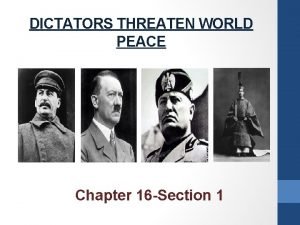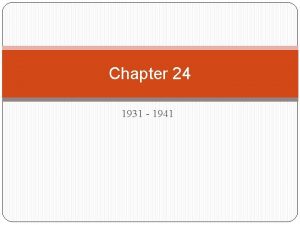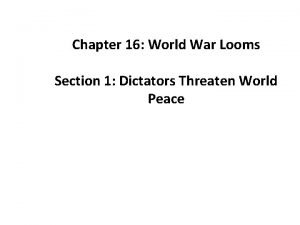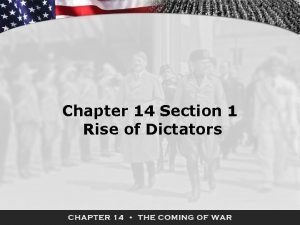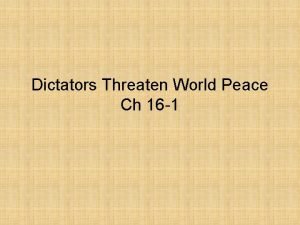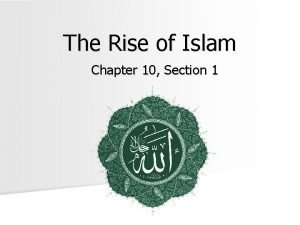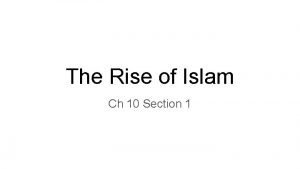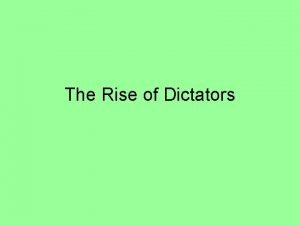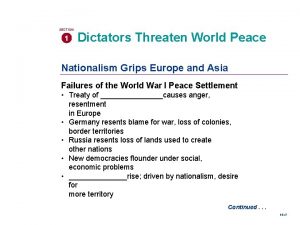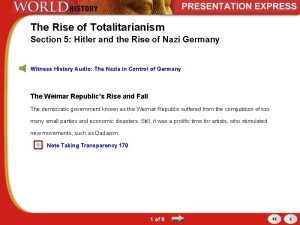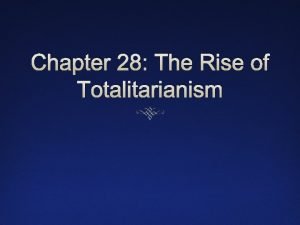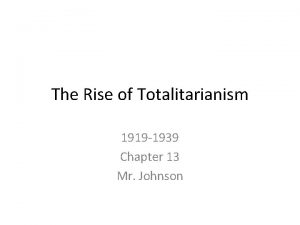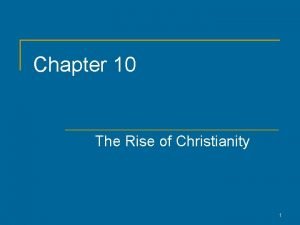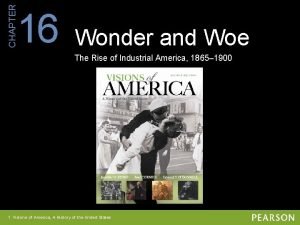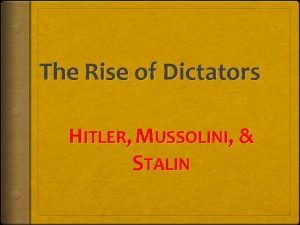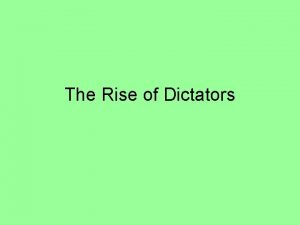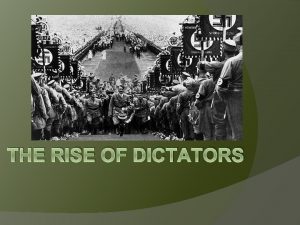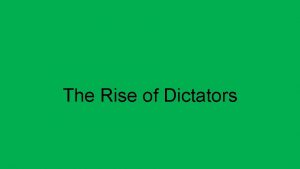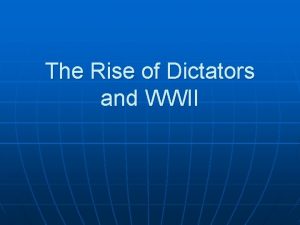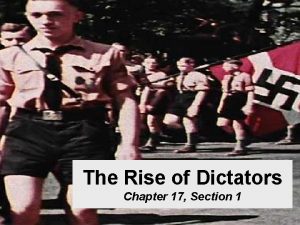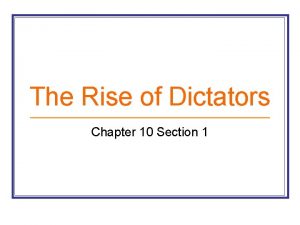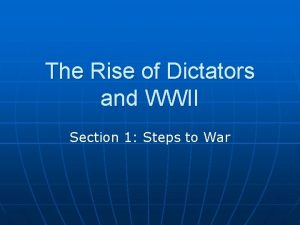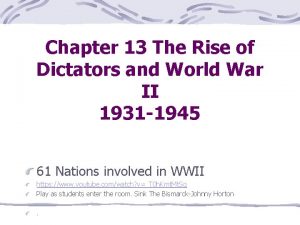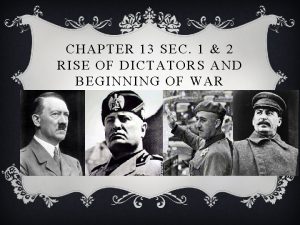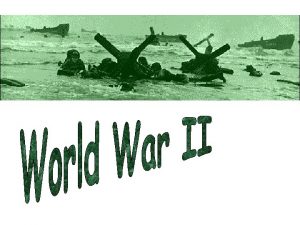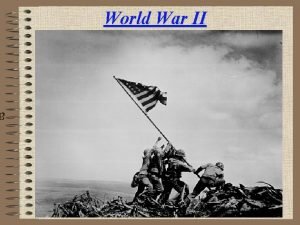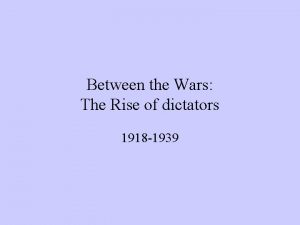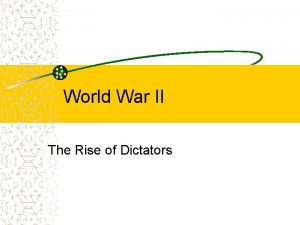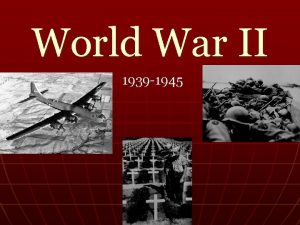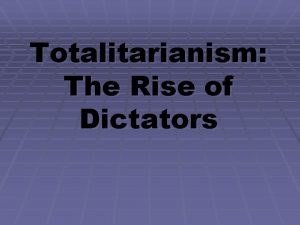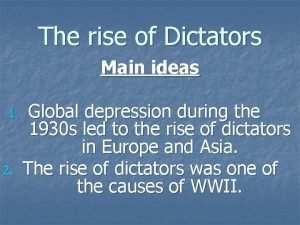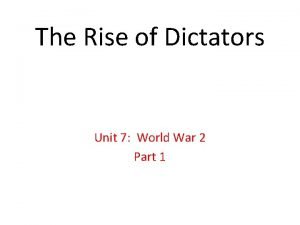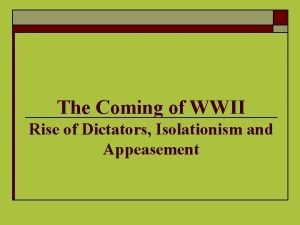Chapter 14 Section 1 Rise of Dictators What

























- Slides: 25

Chapter 14 Section 1 Rise of Dictators

What caused WWII?

Objectives • Explain how dictators and militarist regimes arose in several countries in the 1930 s. • Summarize the actions taken by aggressive regimes in Europe and Asia. • Analyze the responses of Britain, France, and the United States to the aggressive regimes.

Terms • totalitarianism − theory of government in which a single party or leader controls the economic, social, and cultural lives of its people • anti-Semitic − prejudiced against Jewish people • Spanish Civil War − Spanish conflict fought from 1936 to 1939 • appeasement − policy of granting concessions to a potential enemy in the hope that it will maintain peace

Terms (continued) • Anschluss − union in which Hitler forced Austria to become part of Germany’s territory • Munich Pact − agreement in which Britain and France attempted to preserve peace by allowing Hitler to take more territory

World War I ended when Germany surrendered to the Allies. An uneasy peace followed. • Germans resented the terms of the Treaty of Versailles, feeling humiliated in defeat. • Italy and Japan were angered by the treaty, expecting to receive more land as Allied victors. • Worldwide depression brought despair to many already suffering from war.

UNFAIR

BLAME

REPARATIONS

ARMY (OR LACK OF ONE)

TERRITORY (LOST)

Overwhelming problems led some to turn to a new form of government called totalitarianism.

Totalitarian governments developed in several countries during the 1930 s. Country Leader Soviet Union Joseph Stalin Italy Benito Mussolini Germany Adolf Hitler Each of these countries faced crushing problems. Unemployment, hunger, and homelessness were rampant.

Totalitarian leaders promised to bring jobs, food, and prosperity. They promised to make their countries great again. In reality, however, the brutal tactics used by totalitarian leaders resulted in the deaths of millions of people.

Joseph Stalin took control of the Soviet Union following the death of Vladimir Lenin. • Attempted to turn the Soviet Union into an industrial power • Forced people to work in factories and on state-run farms • Killed or imprisoned suspected traitors during the Great Terror • Ruled through fear and massive propaganda

Another totalitarian regime formed in Italy. • The government seemed unable to deal with the country’s many problems. • Benito Mussolini formed the Fascist Party. • Mussolini and his followers, the Black Shirts, fought to gain power. Mussolini, called Il Duce, took control of the government, using secret police to maintain control.

In Germany, the Weimar Republic struggled with overwhelming economic and social problems. Adolf Hitler, the leader of the Nazi Party, was appointed chancellor. Hitler seized power and created a totalitarian state.

Hitler rebuilt the nation’s army. His economic policies put people back to work. Many cheered his success. Yet Hitler ruled with unlimited power. • Controlled the press and education system • Used propaganda to boost his popularity • Used the secret police to silence opposition Violently anti-Semitic, Hitler openly attacked Jews, blaming them for all of the country’s problems.

Japan did not become a totalitarian dictatorship, but it did come under the influence of strong military leaders. These leaders attempted to solve their country’s economic problems through aggressive military conquests. Emperor Hirohito

Japanese Expansion, 1931 -1939 Japan invaded Manchuria, then China. The attack on Nanjing was especially brutal.

Acts of Aggression in Europe and Asia Germany • • • Italy • invaded Ethiopia Spain • Fascists rebel against the government Japan • conquered Manchuria and parts of China rebuilt military reclaimed Saar region from France invaded the Rhineland Anschluss invaded the Sudetenland Nazi-Soviet Non-aggression Pact

A weak League of Nations did little to stop the aggression of the totalitarian states or of Japan. • Many feared involvement in another war. • Some believed the Soviet Union posed a greater threat than Nazi Germany. • Others questioned the resolve of their own country and their allies, and embraced a policy of isolationism.

The appeasement of Hitler continued with the Munich Pact. Britain and France sacrificed the Sudetenland to Germany in return for peace. But peace was not to come.

Nazi-Soviet Non. Aggression Pact

 Rise of dictators graphic organizer
Rise of dictators graphic organizer Chapter 16 dictators threaten world peace
Chapter 16 dictators threaten world peace Chapter 24 world war looms
Chapter 24 world war looms Chapter 24 section 1 dictators threaten world peace
Chapter 24 section 1 dictators threaten world peace Stalin vs mussolini venn diagram
Stalin vs mussolini venn diagram Chapter 14 section 2 totalitarianism
Chapter 14 section 2 totalitarianism Chapter 16 dictators threaten world peace
Chapter 16 dictators threaten world peace Rise and rise until lambs become lions
Rise and rise until lambs become lions Richard nixon tricky dicky
Richard nixon tricky dicky Rise again and again until lambs
Rise again and again until lambs A union b example
A union b example Chapter 10 section 1 the rise of islam
Chapter 10 section 1 the rise of islam Chapter 10 section 1 guided reading the rise of islam
Chapter 10 section 1 guided reading the rise of islam Chapter 6 section 3 guided reading the rise of christianity
Chapter 6 section 3 guided reading the rise of christianity The rise of islam chapter 10 section 1
The rise of islam chapter 10 section 1 Dictators threaten world peace
Dictators threaten world peace Dictators threaten world peace
Dictators threaten world peace Rome after the punic wars
Rome after the punic wars The rise of totalitarianism section 5 quiz
The rise of totalitarianism section 5 quiz The rise of totalitarianism section 1 quiz answer key
The rise of totalitarianism section 1 quiz answer key Section quick check chapter 10 section 1 meiosis answer key
Section quick check chapter 10 section 1 meiosis answer key Chapter 13 the rise of totalitarianism
Chapter 13 the rise of totalitarianism Chapter 13 the rise of a mass democracy
Chapter 13 the rise of a mass democracy Chapter 10 the rise of christianity
Chapter 10 the rise of christianity The rise of industrial america chapter 16
The rise of industrial america chapter 16 Chapter 10 the rise of christianity
Chapter 10 the rise of christianity

